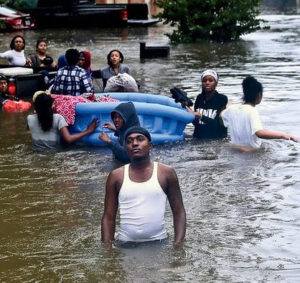
So, in a few weeks, I’m giving a talk called Recipes for Disaster: The Art of the Disaster Narrative at the Hippocamp literary conference, which means lately I’ve been reading tons of stories about hurricanes, wildfires, earthquakes, tornadoes, floods.
Amid the wealth of really great disaster writing out there, there are still some pernicious, persistent clichés. They sneak into the good stories— and they’re why the bad ones are so bad.
I don’t mean just overused, trite words and phrases, though they’re definitely ubiquitous.
Rather, many writers lean heavily on larger themes that are also overused, and are frequently based on myths. When we reuse them, we not only write mediocre stories, we perpetuate stereotypes and falsehoods that really need to die.
Today, let’s retire a stubborn but very popular one: The breathless-surprise story about average people rushing to help during and after a crisis. Like this (real) example:
These Seven Rescue Stories Prove That Even When A Disaster Like Hurricane Harvey Strikes, People Can Band Together.
Note the “even” and “people can.” Thrumming beneath those word choices—and beneath hundreds of similar stories—is the myth that during a scary, life-threatening incident, people will panic. They will be selfish. In a disaster zone, we expect another cliché: Every man for himself.
Wrong.
Research shows that in the midst of life-threatening disasters, civilians rescue more survivors than EMTs or National Guardsman. Research shows that disasters trigger a wave of volunteerism that lasts long after the immediate threat is over. In fact, emergency managers call that crush of would-be helpers a “mass assault.”
Altruism after disaster is not the exception; it’s the rule.
I lived in New York City after September 11th, and I can tell you it’s deeply moving to witness that mass assault of strangers hurtling toward your city, wanting to help. I vividly recall the warm gush of gratitude and awe I felt watching a busload of strangers from Georgia disembarking on 14th Street, ready to do whatever New Yorkers needed.
Writers, though, must look past their emotions. We must dig more deeply. Who are those strangers? Who are they helping? What is happening in this dynamic that could only happen here?
Those busloads of volunteers flooding New York City? A few of them actually didn’t want to do whatever New York needed. They wanted only to work at Ground Zero. They wanted specifically to meet firefighters. They complained when told not to ask firefighters for selfies.
As a story, it’s not as uplifting as Can You Believe This Altruism? It’s better. It’s unique, it’s honest, and it illuminated a side to the disaster previously shrouded in a cloud of clichés. Which is what all good storytelling should do.

Kelly Caldwell
Dean of Faculty


